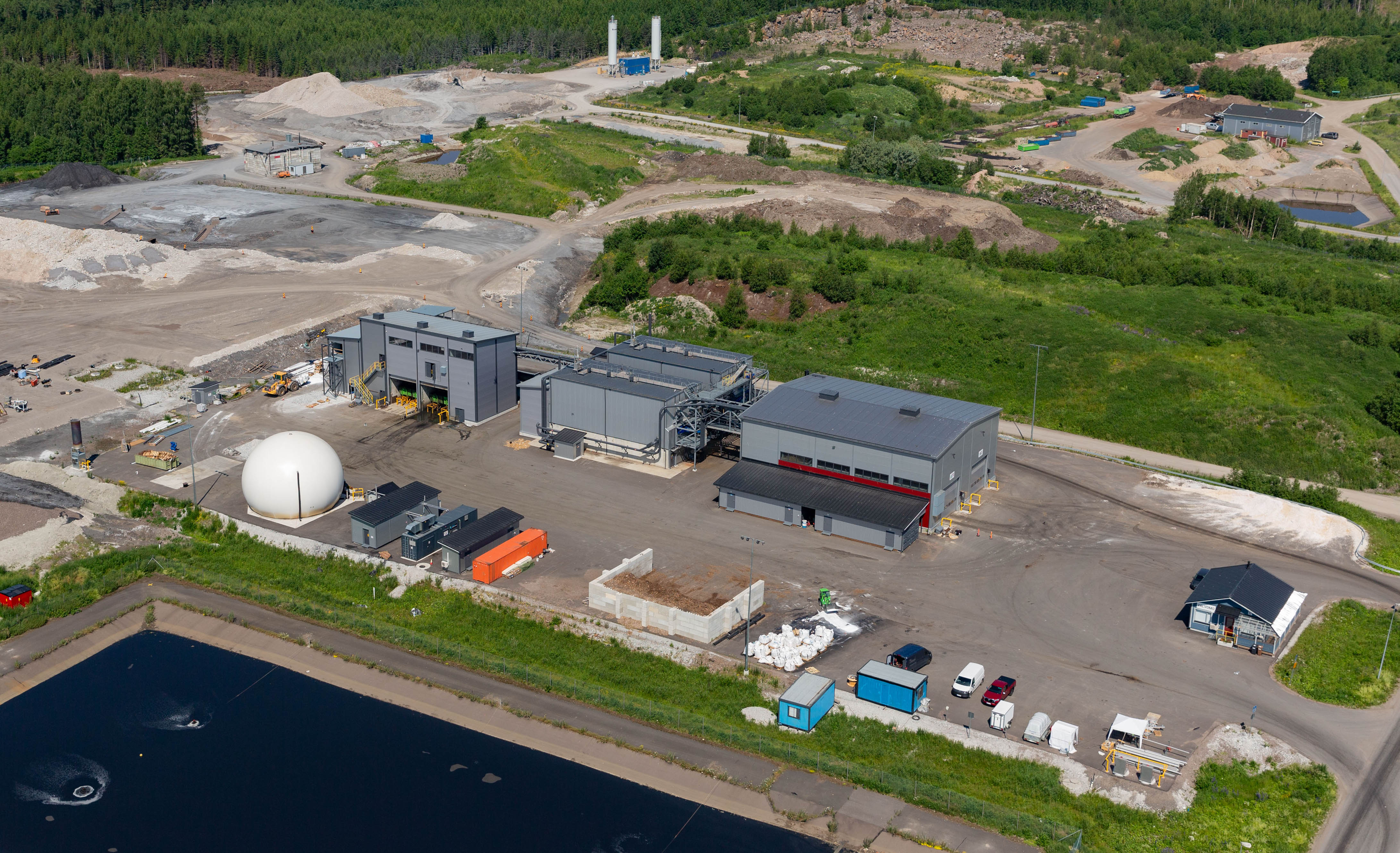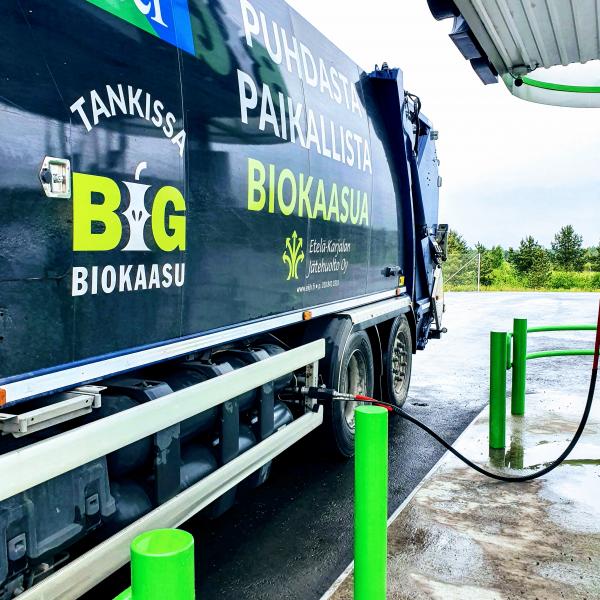ETELÄ-KARJALAN JÄTEHUOLTO OY USES BIOWASTE FROM THE RESIDENTS OF SOUTH KARELIA AND SLUDGE FROM SEWAGE TREATMENT PLANTS TO PRODUCE BIOGAS UTILISED AS TRANSPORT FUEL. COMMISSIONED IN 2020, THE KUKKUROINMÄKI BIOGAS PLANT HELPS THE OWNER MUNICIPALITIES TO ACHIEVE THEIR ENVIRONMENTAL GOALS BY REDUCING TRANSPORT EMISSIONS IN THE REGION.
The biogas filling stations in Imatra, Luumäki, Parikkala and Lappeenranta were opened in April 2021. During 2021, Etelä-Karjalan Jätehuolto sold 905,400 kg of biogas, amounting to 12,585 MWh of energy. With this amount of energy, a car could travel approx. 18 million kilometres, i.e. almost 450 times around the world without greenhouse gas emissions: the calculated CO2 emissions of biogas during driving are zero.
– The region’s transport emissions had been identified as a challenge, and this biogas plant was one way of finding a solution, says Mika Suomalainen, Managing Director of Etelä-Karjalan Jätehuolto.
Biogas for the needs of South Karelia
The Kukkuroinmäki biogas plant is based on dry technology. The dry process is particularly suitable for the treatment of biowaste and saves both energy and water. The biogas plant has two lines: one for biowaste and one for sewage sludge.
The plant processes sludge and separately collected biowaste from the whole of South Karelia. Etelä-Karjalan Jätehuolto takes care of the waste management of around 125,000 people and empties about one million waste bins each year. Recycling means reduced emissions and lower waste fees for residents.
– We only sell biogas in South Karelia. The benefit from the fees comes to us, and since we do not distribute dividends as a municipally-owned company, we can curb the increase in fees.
Etelä-Karjalan Jätehuolto has been arranging waste transport through competitive tendering throughout South Karelia since 2013. The Lappeenranta area alone is divided into five contract areas, which have saved approximately one million euros of local residents’ money through competitive tendering. There are about 30 similar companies in Finland, but few have such extensive services as Etelä-Karjalan Jätehuolto.
– Not all municipalities in Finland are yet covered by municipal waste management, but everyone will be in a couple of years’ time with the new waste legislation, Mika Suomalainen says.
A model region for recycling
According to Suomalainen, the recycling rate in South Karelia is among the highest in the country. Nevertheless, approximately 25% of the weight of dry waste is biowaste. When biowaste is dropped into the dry waste bin, it is loaded onto trucks and transported to the waste incineration plant in Riihimäki.
– Approximately 5,000 tonnes of biowaste is sent to Riihimäki every year. This amount could also be processed at our biogas plant, so it would benefit South Karelia. Unsorted waste only causes unnecessary costs for us.
The treatment capacity of the Kukkuroinmäki biogas plant is currently 19,900 tonnes, of which the share of sludge is around 13,600 tonnes. Each year, Etelä-Karjalan Jätehuolto collects 6,000–6,500 tonnes of biowaste separately. The biogas plant operates at the planned capacity, but the capacity could be increased from the current level.
– We could increase the raw material input by 20–25%. We know exactly how much raw material we are getting. Based on this information, we designed the biogas plant such that we can increase production by a quarter, Suomalainen says, adding:
– We would be glad to receive more raw material, especially sludge, because it is easy to process and the resulting gas is cleaner.
By contrast, biogas from biowaste is impure and its quality varies from season to season. For example, citrus fruits generate a poison, which is a challenge for gas purification.
– The quality also varies depending on where the biowaste is collected. By contrast, the quality of sludge doesn’t vary much, as poop is similar in Imatra and Lappeenranta, Suomalainen says.
From home to the tank through many twists and turns
The journey of biowaste from a separate collection point to a gas car’s tank entails many phases. Once the waste enters the biogas reactor, it passes through the process in less than a month. In total, 1,200 cubic metres of decomposing mass are constantly being digested in the reactor.
– When your biowaste bag goes in there, it takes about three weeks for it to go through all the phases. But because there is so much capacity, it may stay in the reactor for up to 50 days.
The biogas production process also requires some supporting raw material. Kukkuroinmäki utilises garden waste collected in South Karelia, meaning twigs and branches that are used to make wood chips suitable for the process.
– Wood chips from twigs help to drain the liquid, as they enhance compaction in the drying screw. In addition, they form carbon, which is also needed in the biogas process.
Crude gas is produced in the reactor around the clock, every day of the year. Methane accounts for about two-thirds of the crude gas and carbon dioxide for about one-third. From the reactor, the gas is pumped into an intermediate storage facility, from where it proceeds to the gas processing unit. Biogas refined into transport fuel is transferred to filling stations by tanker vehicles, with the exception of the Kukkuroinmäki station, to which the gas is transferred via pipelines.
– Methane accounts for 97% of the gas coming from the gas processing unit. Carbon dioxide is separated from methane with a membrane separator, says Suomalainen.
The nutrient-rich liquid produced in the biogas process can be utilised as a liquid fertiliser and soil improver. As a result of the process improvement, soil improvement products can also be processed from solid processing residue and recycled back into the soil of South Karelia.
Demand exceeds capacity
According to Suomalainen, the demand for biogas produced by Etelä-Karjalan Jätehuolto is so high that the company’s own production is not sufficient to cover it. Therefore, Etelä-Karjalan Jätehuolto buys liquefied biogas from Etelä-Savon Energia and feeds it to the filling stations when needed. One reason for the high demand is the low price of biogas.
– Kukkuroinmäki has the lowest price for biogas in Finland, €1.38 per kg (13 February 2023). We want to keep the price low so that as many people as possible use biogas. Slightly over half of our gas goes to heavy traffic.
The plant generates so much crude gas that it would be possible to produce 1.5 times more methane, but the current gas compressor limits the processing capacity. The Board of Etelä-Karjalan Jätehuolto has already made a decision to acquire a larger gas reactor.
– With a bigger gas compressor, we can refine more gas and will no longer need to purchase gas.
It is also possible to build a third processing line at the Kukkuroinmäki biogas plant if demand continues to grow.
– The third line is easy to build at the plant, but it would mean an additional investment of approximately €5 million, Suomalainen explains.
For more information, please contact:
Etelä-Karjalan Jätehuolto Oy
Mika Suomalainen, mika.suomalainen@ekjh.fi , tel. +358 10 841 1802


